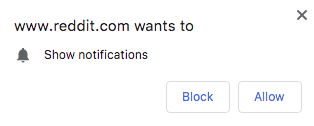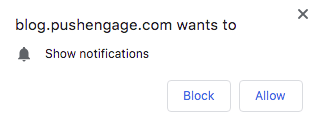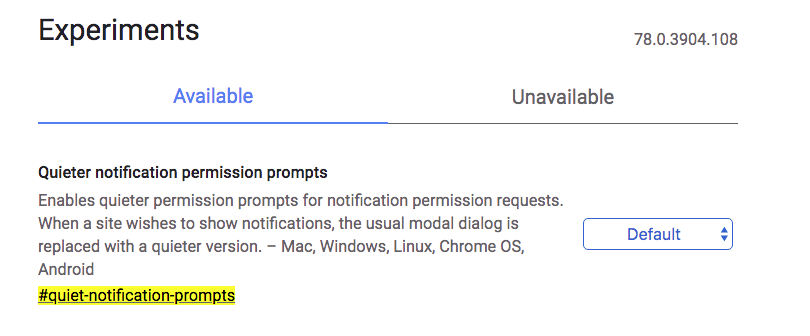Turn Chrome Notifications Off For Good
Browser notifications can be helpful. Sometimes.
They can also be a frustrating imposition.
Google Chrome has a notification systems that lets you receive push notifications from websites whenever you’re online. Even when you’re no on that website.
Unlike standard web notifications, you don’t have to have the website open in your browser to receive them. And unlike app notifications, you don’t have to have the app open to receive them. As long as you’re online, you get the notification.
Websites have to ask if you want to receive notifications, and they need your sign-up to send them to you.
You’ve probably seen one of these requests:

Or this:

They look the same regardless of which website sends them because they’re a standard feature provided by Chrome.
Click “Allow,” and you’ll get one (or more) of these:

Click “Close” and the notification goes away. Click the notification itself and you’ll be taken to the URL the notification refers to.
Some sites will deluge you with these notifications, making it difficult to concentrate, interrupting work and leisure alike with their demands for your attention. Some sites get aggressive enough that it feels like spam and malware.
As a direct, real-time line of communication with users, they’re popular with marketers. But users, besieged by notifications from dozens of different websites, often feel differently.
For years I rejected each of these notification requests manually.
But what if I told you that you could turn the requests off permanently?.
It’s true. You can turn all of them off right in Chrome itself. You’ll never get another notification request ever again.
How to turn off Chrome Notifications on desktop
These instructions should work across operating systems (except Chrome OS—instructions for that below). Whether you’re using Mac, Windows, or Linux, desktop Chrome is configured the same and these steps should stop you getting notification requests.
First, go to Chrome > Settings.
Scroll to the bottom and click “Advanced,” then choose “Site settings” under “Privacy and Security.” Click “Notifications,” and select how you’d like notifications to work. You can:
- Block them all by turning off “Ask before sending.”
- Block a site by clicking “Add” next to “Block,” entering the site and clicking “Add” again.
- Allow a site. Next to “Allow,” click “Add,” enter the site and click “Add” again.
How to turn off Chrome Notifications on Android
Android lets you block all notifications directly in Chrome, as well as blocking websites individually if you prefer.
To block Chrome Notifications on Android from all sites:
- Go to Chrome > More > Settings, and tap “Site Settings.”
- Tap “Notifications” and flip it to Off.
To block only some notifications:
- Go to the website you want to block and tap More > Info.
- Tap Site Settings > Notifications. If this setting isn’t displayed, the website cannot send you notifications. If it is displayed you can set it to Block and notifications from that website will be blocked.
How to turn off Chrome Notifications on iOS
Chrome Notifications don’t work on iOS devices. So there’s no need to manage them or turn them off: if you’re an iOS user, you won’t get Chrome Notifications at all.
There’s an irony here in that Apple was a pioneer of in-app notifications on iOS, but the reason is simple enough: Apple doesn’t like the security issues that Notifications causes (more on that later).
How to turn off Chrome Notifications on Chromebooks
Next to the clock, click the notification. It looks like an app or extension icon with a number next to it.
- To dismiss a single notification click the “Remove” cross icon.
- To dismiss all notifications on your Chromebook, click the “Clear All” icon.
- To stop future notifications, click “Settings.” You’ll see a list of sites, applications and extensions that are allowed to send you notifications. Uncheck the box next to the ones you want to block. There’s no master switch to uncheck them all, unfortunately.
Will this stop Chrome Notifications spam?
Chrome Notifications lets websites talk to you whenever they want. Most sites will use the channel to say “Hey! Look at this!”—annoying if you don’t want to, but legit in its own terms. Others will use the channel for things like spam and in efforts to sell you dubious software and services.
You can’t get malware sent directly to your computer through Chrome Notifications: the content of the messages is supplied by the website, but the message itself is sent by Chrome, so it can’t be used as a direct infection channel. What it can be used for is sales messages for malware, like these:

These are notifications intended to lure users to websites that will try to get them to download compromised versions of common software, or totally unrelated malware.
The good news is these notifications don’t come from a source that “lives” on your computer. There’s nothing to uninstall, and you don’t need to get an anti-malware tool to do hard-drive root canal work and make sure there’s nothing nasty still lurking on your directories. All you have to do is disable Chrome Notifications.
All Chrome Notifications come with the URL of the website that sent them, so you can match that to a site in your “Allow” list and block it, or you can disable notifications altogether. And it goes without saying, don’t click notifications like these and definitely download anything.
Chrome Notifications and Security
Chrome Notifications cannot be used to directly infect your computer with malware or to spy on you.
But they can be used as an infection channel for malware, via phishing and social engineering, which sometimes starts at signup.
In this instance, a video website has told visitors that they have to click “Allow” to watch the video.

In fact, if they do, they’ll be taken to yet another site, and perhaps asked to do the whole thing again. Meanwhile, they’re giving permission to dubious sites they don’t know very well to contact them at will.
In most cases, you can just block the site sending the notifications, or all notifications if you prefer. If you’ve been tricked into clicking spam notifications already, you might need to get an anti-malware tool to scan your computer, or Time Machine your way back to before you first visited the website. To find out when that was, go to chrome://history/ and enter the site’s URL in the search bar.
Chrome Notifications: The future
Chrome Notifications may be automatically blocked in future. In new builds of Chrome for Android, the flag #quiet-notification-prompts lets users manage their notifications in a more sophisticated way.
Most flags in Chrome can only be enabled or disabled, but some, like #quiet-notification-prompts, have more options. On Android, this flag has three Enable options: the first lets you “Enable” it to let Chrome send a silent push notification to your device letting you know a request to send notifications has been blocked. Then there’s an “Enabled (heads-up notifications)” option that makes the notification request pop up on your screen as a “heads-up.” In both these options, the notification comes with a “Manage” button taking you to the Site settings page for the relevant website, where you can manually unblock notifications.
A third option, “Enabled (mini-infobars),” shows an infobar along the bottom of the screen with a short message letting you know that Chrome blocked the notification request and offering the same “Manage” button as the other two options.
Desktop versions of Chrome have this flag too:

On desktop, it works slightly differently, with both planned options showing an icon in the address bar that will be used to indicate when Chrome has blocked a notification request. The main difference is that one version will have a sliding animation and briefly display a “Notifications blocked” message; in this version, clicking the icon will bring up a bubble explaining that Chrome automatically blocks notification requests, and giving users the option to allow notifications for that particular site.
Most importantly for Chrome on desktop, Chrome may automatically switch to blocking notifications for some people, depending on how often they decline notification requests. If you’re a user who frequently declines notification requests, you may see a message saying that new requests have been “Automatically blocked because you declined notifications a few times.”
Automatically blocking notification requests may be the future of Chrome, but for now, you still have to manage notifications yourself.

